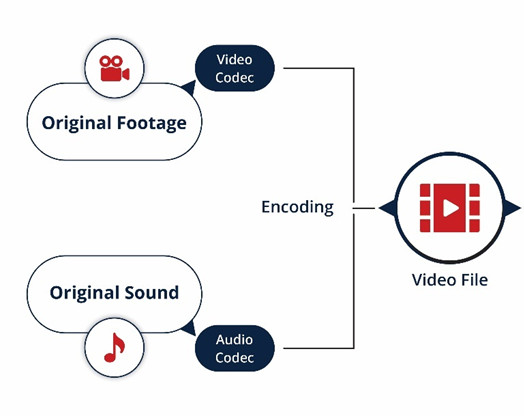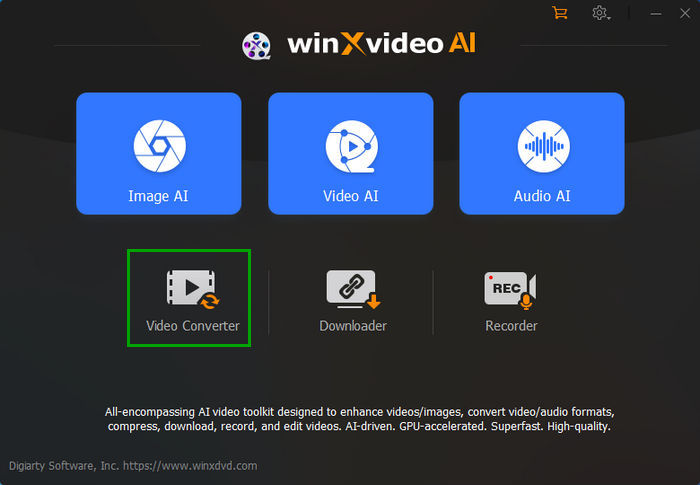Video Encoding: What It is and Why It Matters?
You may hear the words "video encoding" a lot. But what is video encoding? In brief, video encoding is the process of compressing and potentially reformatting raw video content. Why video encoding matters? What are the most common video encoding formats? How to re-encode a video? We'll discuss these points in the rest of this article.
Table of Contents
Part 1. Why Video Encoding is Important?
In the computer world, everything is made up of 0s and 1s. Audio and video data is no exception. Raw audio and video data consumes very large storage space and is not conducive to transmission.
So, how big could be uncompressed/unencoded raw audio and video? Let's take a video with a resolution of 1920×1280 and a frame rate of 30 as an example.
A 1920×1280 image has 2,073,600 pixels. Each pixel is 24bit. So the original size of a 1920×1280 image = 49766400 bits (2073600×24) = 6220800byte ≈ 6.22MB. Next, we multiply 6.22MB by 30 for the frame rate and get 186.6MB. That is to say, the size of a second video is 186.6MB. One-minute video will be about 11GB, and a 90-minute movie is about 1000GB.
In fact, audio and video, especially video, contain a lot of repeated data of 0 and 1, so we can compress the data of 0 and 1 through certain algorithms. Since the picture is gradually transitioned, the whole video contains a lot of picture/pixel repetition, which provides a very large compression space. Therefore, encoding can greatly reduce the size of audio and video data, making audio and video easier to store and transmit over the internet.
Sometimes even if the content is already compressed to an appropriate size, it still needs to be encoded to make it compatible with certain service or program, although this is often and more accurately described as transcoding.
That's why encoding matters.
Additionally, we need to know that video encoding process is dictated by video codecs, or video compression standards. Well, what are video codecs? Let's move on to see.

Part 2. What are Video Codecs?
A video codec is software or hardware that compresses and decompresses digital video. Each codec is comprised of an encoder to compress the video and a decoder to decompress it. The word "codec" is a portmanteau of enCOder and DECoder.
There are many video encoding formats, such as H26x series and MPEG series. These encoding formats emerge to adapt to the development of the times.
The H.26X series (led by ITU [International Teletext Union]) includes H.261, H.262, H.263, H.264, H.265:
- H.261: Mainly used in older video conferencing and video telephony products.
- H.263: Mainly used in video conferencing, video telephony and network video.
- H.264: H.264/MPEG-4 Part 10, or AVC (Advanced Video Coding, Advanced Video Coding), is a video compression standard, a widely used high-precision video recording, compression and distribution format.
- H.265: High Efficiency Video Coding (HEVC) is a video compression standard, the successor of H.264/MPEG-4 AVC. HEVC is considered not only to improve image quality, but also to achieve twice the compression ratio of H.264/MPEG-4 AVC (equivalent to a 50% reduction in bit rate under the same image quality).
MPEG series (developed by MPEG [Motion Picture Experts Group] under ISO [International Standards Organization]) video coding mainly includes:
- MPEG-1 Part II: Mainly used on VCD and some online videos. The quality of this codec is roughly equivalent to the original VHS videotape.
- MPEG-2 Part II: Equivalent to H.262 and used in DVD, SVCD, and most digital video broadcasting systems and cable distribution systems.
- MPEG-4 Part 2: Used for network transmission, broadcasting, and media storage. It has improved compression performance compared to MPEG-2 and the first version of H.263.
- MPEG-4 Part 10: It is technically the same standard as ITU-TH.264, sometimes called "AVC". These two coding organizations cooperated and developed H.264/AVC standard. ITU-T named this standard H.264, while ISO/IEC called it MPEG-4 Advanced Video Coding (AVC).
Apart from H.26X and MPEG series, there are other codecs, such as VP8, VP9, Theora, RealVideo RV40, and AV1.
Video content encoded using a specific video encoding format is usually bundled with an audio stream (encoded using the audio encoding format) within a multimedia container format such as AVI, MP4, FLV, RealMedia, or Matroska. So users typically don't have an H.264 file, but instead have an .mp4 video file, which is an MP4 container that contains H.264 encoded video and usually AAC encoded audio. A multimedia container format can contain any of a number of different video encoding formats. For example, the MP4 container format can contain video in the following formats: MPEG-2 Part 2 or H.264 video encoding format, etc.
Part 3. You May Need to Re-encode Video
The videos we record and export from our cameras are already compressed (or encoded). However, sometimes we still need to re-encode them, because the video or audio encoding format isn't accepted by the device or software we use or because the file size is too large to handle or send. In this case, you will need to use a third-party video encoder such as Winxvideo AI. What can this video encoding software do? Check the features below.
- Change video encoding format, such as H.264 to H.265 or vice versa, XAVC to H.264. It can decode 320+ video codec formats and re-encode to popular formats.
- Change audio encoding format. Support more than 50 audio codec formats.
- Reduce video file size by changing bitrate, lowering resolution, trimming off unwanted clips.
- Built with over 420 profiles, helping users output a video compatible with all popular devices and programs.
- Being equipped with High Quality Engine, it won't cause visual quality loss during transcoding.
- Utilize GPU acceleration to boost video decoding and encoding.
- AI upscale video to 1080p/4K, stabilize shaky footage, boost FPS from 24 to 60/120 and even higher. Restore and enhance image to 4K/8K/10K.






















